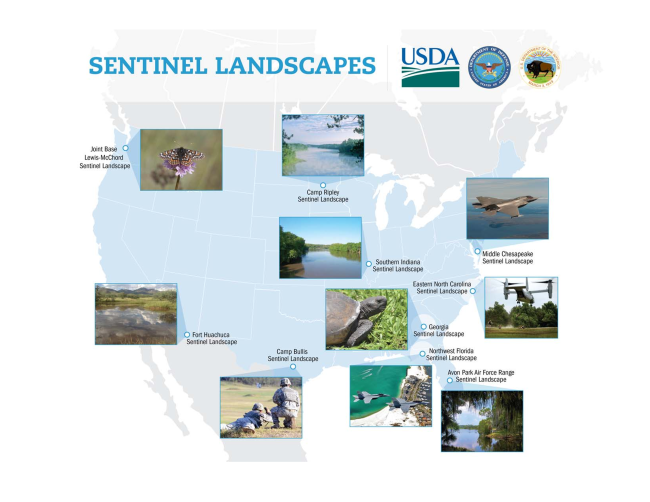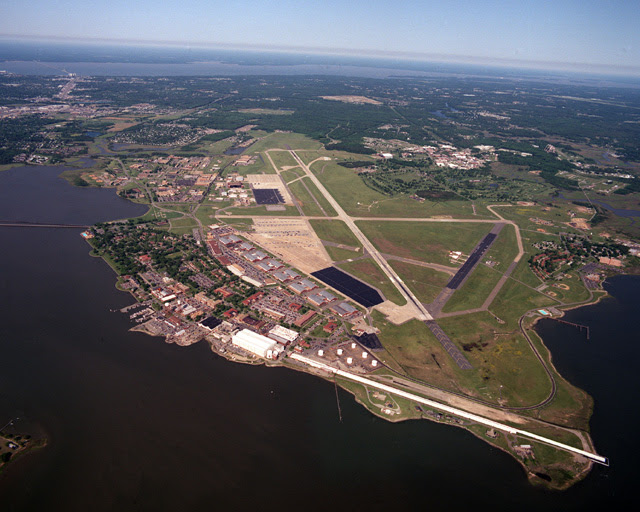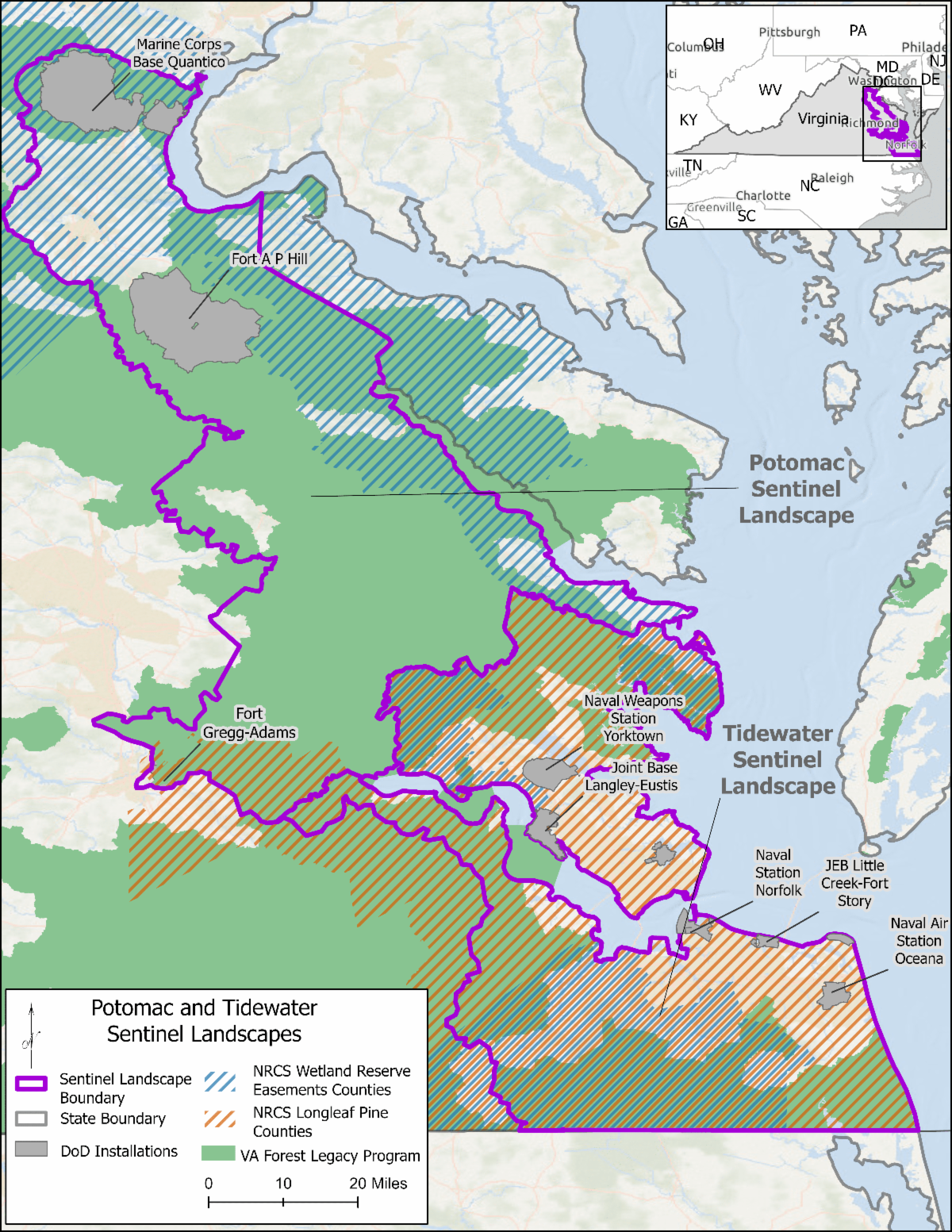Joint Base Langley Eustis, anchor point of the Tidewater Sentinel Landscape
Written by Mike Bonnell
In a recent monumental win for collaborative conservation in the Chesapeake Bay, the Sentinel Landscapes Partnership announced the establishment of new Sentinel Landscapes in Virginia. Covering more than 2.9 million acres, the Virginia Security Corridor, as it’s called, is made up of the Potomac and Tidewater Sentinel landscapes., and. The designation comes from the collaboration of more than nine federal agencies (and Chesapeake Conservation Partners), such as the Department of Defense (DOD) REPI program, the National Park Service and the US Department of Agriculture (USDA). This designation will make great strides in land protection and conservation of natural resources for years to come.
The Sentinel Landscapes Partnership was established in 2013 via a Memorandum of Understanding between the DOD, USDA and the Department of the Interior. The agencies collaborate to manage swaths of land that exist at the intersection of military training grounds, natural resources, agriculture and valued species habitat. Each locale is anchored by one or more military installations or training grounds and holds high-value land for the DOI and USDA. The participating federal agencies leadership then collaborates further with local and regional governments, tribes, landowners, nonprofits and other stakeholders to plan for the future of the landscape. The federal agencies can also more effectively point landowners and nonprofits in the direction of funding and other programs that support land management practices. With the new Virginia Security Corridor, there are now 12 Sentinel Landscapes throughout the United States.

The previous Sentinel Landscapes, which now include the Virginia Security Corridor
- Prevent encroachment on military testing and training activities while supporting Virginia’s working lands
- Build resilience against climate-induced hazards
- Conserve and restore key habitats to benefit water quality and protected species
In addition, the landscape will provide regional connectivity between the already existing Middle Chesapeake and Eastern North Carolina Sentinel Landscapes for even larger scale coordination. In addition to other vital efforts around the Chesapeake like, Chesapeake WILD, this Sentinel Landscape will improve essential species corridors and enhance habitat conservation efforts.
A map of the new Sentinel Landscape and DOD facilities that anchor it.
Many other partners of the Chesapeake Conservation Partnership were also involved in the recent designation, including Capital Region Land Conservancy, Ducks Unlimited, American Battlefield Trust, Piedmont Environmental Council, The Conservation Fund, The Trust for Public Land and the Nature Conservancy, as well as Virginia’s Departments of Conservation & Recreation and Wildlife Resources.
Though the designation was announced just recently, there are already some specific efforts in progress to improve the landscape. The population growth and development taking place in the Golden Crescent is encroaching on prime forest and farmlands. Partners located within the new Sentinel Landscape are collaborating with the American Forest Foundation to pilot an expansion of their Family Forest Carbon Program. This program provides capacity for landowners to increase carbon capturing capabilities on their land and access the carbon markets necessary to sell their carbon credits. This will improve and incentivize forest and farm conservation for landowners of all kinds in the new landscape.
“The Chesapeake Bay is a critical region for national security,” said Kristin Thomasgard, program director for the Department of Defense’s Readiness and Environmental Protection Integration Program. “The establishment of the Virginia Security Corridor Sentinel Landscapes provides DOD with new opportunities to work with our government and community partners to preserve open space, protect habitats and build resilience to climate change around key military installations in Virginia.”
This exhilarating establishment of a new Sentinel Landscape is part of 2023’s slate of announcements. The Sentinel Landscapes Partnership is currently accepting expressions of interest for new designations in 2024, with a deadline of July 27th, 2023. Any entity with an aligning mission is eligible, including F\federal agencies, federally-recognized Tribes and other Indigenous communities and both for-profit and nonprofit organizations. Selected applicants will then have 60 days to submit full proposals, and the new slate of Sentinel Landscapes will be announced in April 2024. Visit the Sentinel Landscape Partnership website for more information. For general questions on the Sentinel Landscape program, email [email protected].
Efforts like the Sentinel Landscapes are exemplary efforts of large landscape conservation and collaboration. Bringing together a large number of partners with different overall missions but the same interest in using and protecting land effectively leads to the greatest amount of success.
Photo Credit:
- Wikimedia Commons
- Sentinel Landscapes Partnership
- Sentinel Landscapes Partnership
Lightning Update is a regular communication of the Chesapeake Conservation Partnership. Any opinions expressed are those of the authors and do not necessarily reflect positions of the Partnership or member organizations.
To share a success story, news, or important event, send your information to:
Support for the Chesapeake Conservation Partnership is provided by:
National Park Service Chesapeake
EPA Chesapeake Bay Program
USDA Forest Service
Pennsylvania Department of Conservation & Natural Resources
Maryland Department of Natural Resources
Virginia Outdoors Foundation
US Fish & Wildlife Service
Chesapeake Conservancy
The Chesapeake Conservation Partnership is co-convened by:





